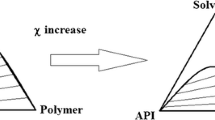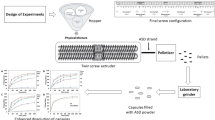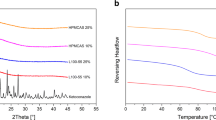Abstract
Amorphous solid dispersions (ASDs) are inherently unstable because of high internal energy. Evaluating physical and chemical stability during the process and storage is essential. Numerous researches have demonstrated how polymers influence the drug precipitation and physical stability of ASDs, while the influence of polymers on the chemical stability of ASDs is often overlooked. Therefore, this study aimed to investigate the effect of polymers on the physical and chemical stability of spray-dried ASDs using dipyridamole (DP) as a model drug. Proper polymers were selected by assessing their abilities to inhibit drug recrystallization in supersaturated solutions. HPMC E5, Soluplus®, HPMCP-55, and HPMCAS-LP were shown to be effective stabilizers. The optimized formulations were further stored at a high temperature (60 °C) and high humidity (40 °C, 75% RH) for 2 months, and their physical and chemical stability was evaluated using polarizing optical microscopy, FTIR, HPLC, and mass spectrometry (MS). In general, crystallization was observed in all samples, which indicated the physical instability under stressed storage conditions. Also, it was noted that the polymers in ASDs rather than physical mixtures, induced a dramatic drug degradation after being exposed to a high temperature (HPMCP-55 > 80% and HPMCAS-LP > 50%) and high humidity (HPMCP-55 > 40% and HPMCAS-LP > 10%). The MS analysis further confirmed the degradation products, which might be generated from the reaction between dipyridamole and phthalic anhydride decomposed from HPMCP-55 and HPMCAS-LP. Overall, the exposure of ASDs to stressed conditions resulted in recrystallization and even the chemical degradation induced by polymers.








Similar content being viewed by others
Abbreviations
- ASD:
-
Amorphous solid dispersion
- SDs:
-
Solid dispersions
- DP:
-
Dipyridamole
- PMs:
-
Physical mixtures
- HPMC E5:
-
Hydroxypropyl methyl cellulose E5
- PVP K30:
-
Poly vinyl pyrrolidne K30
- PVPVA 64:
-
Polyvinylpyrrolidone vinyl acetate
- Eudragit® L100:
-
Eudragit® L100-55
- HPMCP:
-
Hydroxypropyl methyl-cellulose phthalate NF
- HPMCAS:
-
Hydroxypropyl methylcellulose acetate succinate LF
References
Ellenberger DJ, Miller DA, Kucera SU, Williams RO. Improved vemurafenib dissolution and pharmacokinetics as an amorphous solid dispersion produced by KinetiSol® processing. AAPS PharmSciTech. 2018; https://doi.org/10.1208/s12249-018-0988-1.
Guan J, Liu Q, Zhang X, Zhang Y, Chokshi R, Wu H, et al. Alginate as a potential diphase solid dispersion carrier with enhanced drug dissolution and improved storage stability. Eur J Pharm Sci. 2018;114:346–55. https://doi.org/10.1016/j.ejps.2017.12.028.
Albadarin AB, Potter CB, Davis MT, Iqbal J, Korde S, Pagire S, et al. Development of stability-enhanced ternary solid dispersions via combinations of HPMCP and Soluplus® processed by hot melt extrusion. Int J Pharm. 2017;532(1):603–11. https://doi.org/10.1016/j.ijpharm.2017.09.035.
Xu S, Dai WG. Drug precipitation inhibitors in supersaturable formulations. Int J Pharm. 2013;453(1):36–43. https://doi.org/10.1016/j.ijpharm.2013.05.013.
Lee TWY, Boersen NA, Hui HW, Chow SF, Wan KY, Chow AHL. Delivery of poorly soluble compounds by amorphous solid dispersions. Curr Pharm Des. 2014;20(3):303–24.
Lu T, Sun Y, Ding D, Zhang Q, Fan R, He Z, et al. Study on enhanced dissolution of azilsartan-loaded solid dispersion, prepared by combining wet milling and spray-drying technologies. AAPS PharmSciTech. 2017;18(2):473–80. https://doi.org/10.1208/s12249-016-0531-1.
Chauhan H, Hui-Gu C, Atef E. Correlating the behavior of polymers in solution as precipitation inhibitor to its amorphous stabilization ability in solid dispersions. J Pharm Sci. 2013;102:1924–35. https://doi.org/10.1002/jps.23539.
Bley H, Fussnegger B, Bodmeier R. Characterization and stability of solid dispersions based on PEG/polymer blends. Int J Pharm. 2010;390(2):165–73. https://doi.org/10.1016/j.ijpharm.2010.01.039.
Li S, Pollock-Dove C, Dong LC, Chen J, Creasey AA, Dai WG. Enhanced bioavailability of a poorly water-soluble weakly basic compound using a combination approach of solubilization agents and precipitation inhibitors: a case study. Mol Pharm. 2012;9(5):1100–8. https://doi.org/10.1021/mp200352q.
Kim MS, Kim JS, Cho W, Cha KH, Park HJ, Park J, et al. Supersaturatable formulations for the enhanced oral absorption of sirolimus. Int J Pharm. 2013;445(1):108–16. https://doi.org/10.1016/j.ijpharm.2013.01.067.
Loftsson T, Brewster ME. Cyclodextrins as functional excipients: methods to enhance complexation efficiency. J Pharm Sci. 2012;101(9):3019–32. https://doi.org/10.1002/jps.23077.
Anderson BD. Predicting solubility/miscibility in amorphous dispersions: it is time to move beyond regular solution theories. J Pharm Sci. 2018;107(1):24–33. https://doi.org/10.1016/j.xphs.2017.09.030.
Lehmkemper K, Kyeremateng SO, Heinzerling O, Degenhardt M, Sadowski G. Impact of polymer type and relative humidity on the long-term physical stability of amorphous solid dispersions. Mol Pharm. 2017;14(12):4374–86. https://doi.org/10.1021/acs.molpharmaceut.7b00492.
Keratichewanun S, Yoshihashi Y, Sutanthavibul N, Terada K, Chatchawalsaisin J. An investigation of nifedipine miscibility in solid dispersions using Raman spectroscopy. Pharm Res. 2015;32(7):2458–73. https://doi.org/10.1007/s11095-015-1638-x.
Purohit HS, Ormes JD, Saboo S, Su Y, Lamm MS, Mann AKP, et al. Insights into nano- and micron-scale phase separation in amorphous solid dispersions using fluorescence-based techniques in combination with solid state nuclear magnetic resonance spectroscopy. Pharm Res. 2017;34(7):1364–77. https://doi.org/10.1007/s11095-017-2145-z.
Saboo S, Taylor LS. Water-induced phase separation of miconazole-poly (vinylpyrrolidone-co-vinyl acetate) amorphous solid dispersions: insights with confocal fluorescence microscopy. Int J Pharm. 2017;529(1):654–66. https://doi.org/10.1016/j.ijpharm.2017.07.034.
Bochmann ES, Üstüner EE, Gryczke A, Wagner KG. Predicting melt rheology for hot-melt extrusion by means of a simple Tg-measurement. Eur J Pharm Biopharm. 2017;119:47–55. https://doi.org/10.1016/j.ejpb.2017.05.010.
Sun DD, Lee PI. Probing the mechanisms of drug release from amorphous solid dispersions in medium-soluble and medium-insoluble carriers. J Control Release. 2015;211:85–93. https://doi.org/10.1016/j.jconrel.2015.06.004.
Hsieh YL, Ilevbare GA, Van Eerdenbrugh B, Box KJ, Sanchez-Felix MV, Taylor LS. pH-induced precipitation behavior of weakly basic compounds: determination of extent and duration of supersaturation using potentiometric titration and correlation to solid state properties. Pharm Res. 2012;29(10):2738–53. https://doi.org/10.1007/s11095-012-0759-8.
Truong DH, Tran TH, Ramasamy T, Choi JY, Choi HG, Yong CS, et al. Preparation and characterization of solid dispersion using a novel amphiphilic copolymer to enhance dissolution and oral bioavailability of sorafenib. Powder Technol. 2015;283:260–5. https://doi.org/10.1016/j.powtec.2015.04.044.
Patterson JE, James MB, Forster AH, Rades T. Melt extrusion and spray drying of carbamazepine and dipyridamole with polyvinylpyrrolidone/vinyl acetate copolymers. Drug Dev Ind Pharm. 2008;34(1):95–106. https://doi.org/10.1080/03639040701484627.
Miller DA, DiNunzio JC, Yang W, McGinity JW, Williams RO. Enhanced in vivo absorption of itraconazole via stabilization of supersaturation following acidic-to-neutral pH transition. Drug Dev Ind Pharm. 2008;34(8):890–902. https://doi.org/10.1080/03639040801929273.
Friesen DT, Shanker R, Crew M, Smithey DT, Curatolo WJ, Nightingale JAS. Hydroxypropyl methylcellulose acetate succinate-based spray-dried dispersions: an overview. Mol Pharm. 2008;5(6):1003–19. https://doi.org/10.1021/mp8000793.
Shah N, Iyer RM, Mair HJ, Choi DS, Tian H, Diodone R, et al. Improved human bioavailability of vemurafenib, a practically insoluble drug, using an amorphous polymer-stabilized solid dispersion prepared by a solvent-controlled coprecipitation process. J Pharm Sci. 2013;102(3):967–81. https://doi.org/10.1002/jps.23425.
Shah N, Sandhu H, Phuapradit W, Pinal R, Iyer R, Albano A, et al. Development of novel microprecipitated bulk powder (MBP) technology for manufacturing stable amorphous formulations of poorly soluble drugs. Int J Pharm. 2012;438(1):53–60. https://doi.org/10.1016/j.ijpharm.2012.08.031.
Sarode AL, Sandhu H, Shah N, Malick W, Zia H. Hot melt extrusion for amorphous solid dispersions: temperature and moisture activated drug–polymer interactions for enhanced stability. Mol Pharm. 2013;10(10):3665–75. https://doi.org/10.1021/mp400165b.
Zhang M, Li H, Lang B, O’Donnell K, Zhang H, Wang Z, et al. Formulation and delivery of improved amorphous fenofibrate solid dispersions prepared by thin film freezing. Eur J Pharm Biopharm. 2012;82(3):534–44. https://doi.org/10.1016/j.ejpb.2012.06.016.
Riedel A, Leopold CS. Degradation of omeprazole induced by enteric polymer solutions and aqueous dispersions: HPLC investigations. Drug Dev Ind Pharm. 2005;31(2):151–60. https://doi.org/10.1081/DDC-200047787.
Karandikar H, Ambardekar R, Kelly A, Gough T, Paradkar A. Systematic identification of thermal degradation products of HPMCP during hot melt extrusion process. Int J Pharm. 2015;486(1):252–8. https://doi.org/10.1016/j.ijpharm.2015.04.007.
Funding
The work was supported by the China Postdoctoral Science Foundation (Grant No. 2016M602442), the 111 project (Grant No. B16047), and the Natural Science Fund Project of Guangdong Province (Grant No. 2016A030312013).
Author information
Authors and Affiliations
Corresponding authors
Ethics declarations
Conflict of Interest
The authors declare that they have no conflict of interest.
Rights and permissions
About this article
Cite this article
Peng, T., She, Y., Zhu, C. et al. Influence of Polymers on the Physical and Chemical Stability of Spray-dried Amorphous Solid Dispersion: Dipyridamole Degradation Induced by Enteric Polymers. AAPS PharmSciTech 19, 2620–2628 (2018). https://doi.org/10.1208/s12249-018-1082-4
Received:
Accepted:
Published:
Issue Date:
DOI: https://doi.org/10.1208/s12249-018-1082-4




